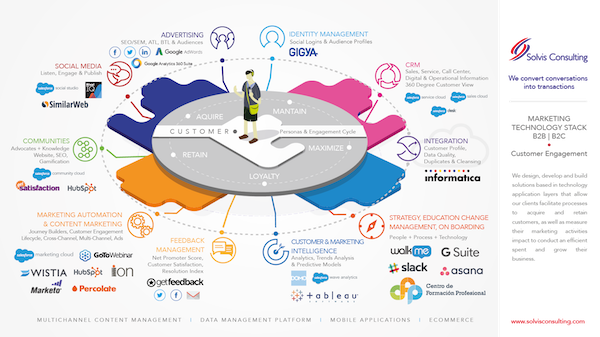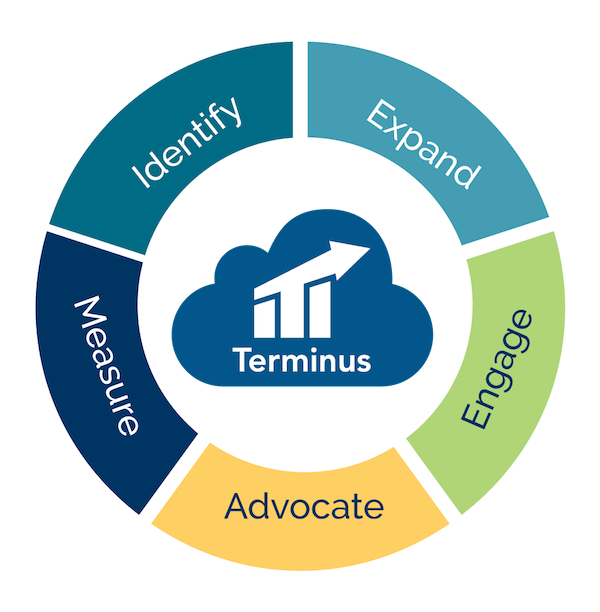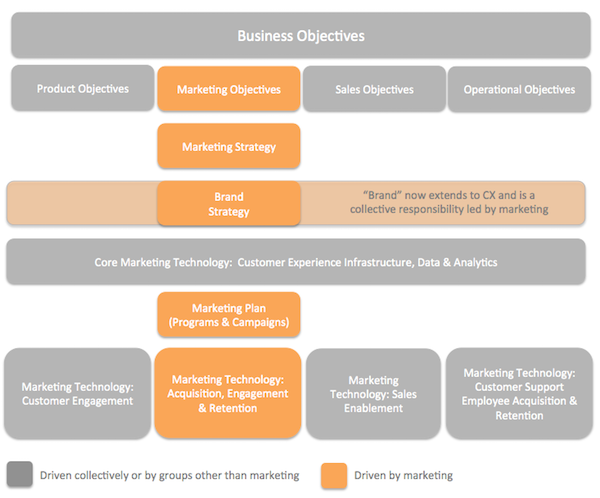This article is a guest post by Jesus Hoyos of Solvis Consulting. It was entered into The Hackies essay contest for the upcoming MarTech conference. Like it? You can register your vote in the contest by sharing it on social media, especially LinkedIn, Facebook, and Twitter.
During the last few years, many vendors and companies had published their marketing technology stacks in the chiefmartec.com contest. There are more than 3,000 technologies and many categories within the industry.
We see day after day the need to integrate marketing with CRM, and now we see the need to make advertising technologies, feedback management, e-commerce and call centers be part of the stack. All of these technologies are becoming the customer engagement ecosystem.
Solvis Consulting wants to share our point of view of managing the stack, not from our the technology point of view, but from the perspective of implementing and using the whole stack to improve and maintain customer relationships for both B2B and B2C markets.
In order to use marketing and customer engagement stack, you need to think about the customer relationship cycle: acquire, maintain, upsell/cross-sell, loyalty and retention.
We are not talking about sales, marketing, or customer service, but processes of relationships where there is an engagement with dynamic journeys — where the customer is in control, not the enterprise.
In our marketing technology Stack, we have put the customer at the center of our ecosystem. We believe in the creating and nurturing relationships where there is a continuous engagement using customer data, processes and people.
To manage this engagement, you need 6 layers of execution to help you organize an agile methodology to use resources, technologies, data and people, and to be able to use your technology stack efficiently:
- Buyer Personas: Is your customer always at the center of the whole strategy? You need his or her preferences and interests using digital, analytical and operational data. Maximize the use of analytics and segmentation to get to know the customer better and offer unique experiences. We prefer to say customer personas instead of buyer persona or lead or prospect. This means that you should have within your CRM the 360-degree view of the customer with the proper data. This should empower your employees to use the data to delight the customers in any transaction; and to make campaigns and journey decisions based on the customer data.
- Customer Relationship Cycle: To manage the relationship with the customer you must know that each touch point is based on opportunities to engage the customer: acquiring, maintaining, maximizing (upsell/cross sell), creating loyalty and retaining. All processes should be 100% focused on the customer, not in marketing, sales or service (no silos). Your ecosystem should be integrated and designed based on the relationship cycle to avoid silos vs. just integrating technologies.
- Channels or Interaction Points: To offer better experiences through any channel such as Facebook, chat, ads, Messenger, mobile app, email, SMS, Twitter, LinkedIn, push notifications, website, POS, call center, voice, etc., you need to have a complete journey mapping of the experiences. We like to say any channel, instead of multi-channel or omni-channel, since the customer dictates how and when to interact with your channels. For example, Facebook has many channels, from videos to ads and from the Fan Page to comments. These many options need to be part of your mapping. Be ready to integrate all of these channels into your CRM system using the 360-degree view of the customer and have a unified inbox or console to manage all communications.
- Technologies: Marketing, advertising, ecommerce, call center, command center, CRM, mobile apps, DMP, MDM, communities, point of sales, feedback management, blogs, etc. Here you need to understand the functionality boundaries between the technologies. For example, understand when to use the HubSpot social media functionality vs. Salesforce Social Studio, or the inbound marketing and nurturing functionality of Marketo vs. the outbound / customer journey functionality of Salesforce Marketing Cloud.
- Customer Data: The stewardship of customer data is super important — from data migration to duplicates and from data quality to master data management. Using tools like identity management and integrating digital data with transactional data will help keep your data quality higher than 95%. The quality of data is essential in order to maintain the customer expectations and to have good customer journeys.
- Governance: Do you have the culture, execution team, processes, skills sets, content campaigns and journeys under an agile plan that has a continuous process of learning? Do you have a change management plan to execute your customer engagement strategy? We have seen that the constant training of employees from CxO to doers is a critical success factor for the governance needed to execute the strategy.
So if you are learning now how to start with a marketing technology stack, you need to be aware of these 6 layers.
Don’t wait to develop a strategy, start with part of your stack, learn and adjust. Become an expert of your stack to help improve the customer engagement. Work in parallel with your strategy and stack, execute and test. Continue improving the stack and the customer engagement. Make decision on metrics and data. Your customers will appreciate this.
What did you think of this article as an entry in The Hackies essay contest for the upcoming MarTech conference? If you liked it, you can register your vote in the contest by sharing it on LinkedIn, Facebook, and Twitter.





